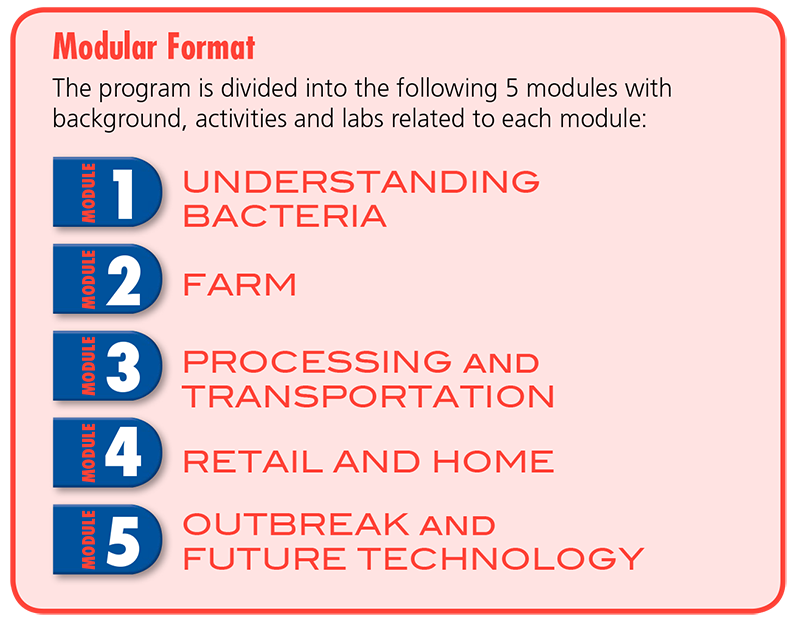Lesson Plan
Ultra High Pressure Treatment (Grades 9-12)
Grade Level
Purpose
Students will explore various ways that have been used to preserve food over the ages. They will also learn about techniques used to process food today and hypothesize about other methods scientists might use to process food safely in the future. Finally, students will conduct a simulation of high pressure treatment and discover how it destroys bacteria without crushing the food. Grades 9-12
Estimated Time
Materials Needed
- 2 empty plastic soda bottles (not rigid bottles)
- 2 grapes
- A variety of foods preserved in different ways, for example: – Tomatoes: fresh, sun-dried, canned – Fish: salted, fresh, canned – Fruit: fresh, dried, canned – Herbs: fresh, dried
- Dr. X and the Quest for Food Safety video, Module 3 — Processing and Transportation
Vocabulary
ultra high pressure treatment (UHP): a method of preserving and sterilizing food, in which a product is processed under very high pressure, leading to the inactivation of certain microorganisms and enzymes in the food
Did You Know?
- The pressure created by two 5-ton elephants balanced on a dime is roughly equal to 60,000 psi (pounds per square inch).
Background Agricultural Connections
Students will discover the relationship between the 4 Cs of Food Safety and food preservation methods. This finding will reinforce their understanding of why the 4 Cs are important in keeping food safe.
Preservation Methods
Preservation methods, such as salting, smoking, drying, canning, and freezing, have been used over the years to preserve food. As our scientific knowledge and engineering skills have advanced, so have food preservation methods. All the early methods preserve food by affecting one or more of the variables needed for bacterial growth, such as temperature, moisture, pH, and nutrients. Many of the preservation methods have a relationship to the 4 Cs of Food Safety.
In order for preservation methods to be accepted, foods need to look and taste good. Scientists need to consider the taste, texture, and nutritional value of the food after it has been processed.
Ultra High Pressure Treatment (UHP)
The benefits of using pressure in the production of foods have been known for over 100 years. However, scientists and engineers have only recently developed the equipment necessary to efficiently and reliably generate the high pressure required to kill bacteria. The most recent use of ultra high pressure treatment is to kill both spoilage microorganisms and harmful pathogens, such as E. coli O157:H7 and Listeria monocytogenes, in foods.
Ultra high pressure treatment (UHP) works by exposing foods to pressure from 50,000 pounds per square inch (psi) to 100,000 psi for a short time (from 30 seconds to slightly more than 2 minutes).
High pressure can impact the life processes (protein function, enzyme action, and cellular membrane function) of living bacterial cells, thus causing the bacteria to die.
You could compare this to a fish accustomed to living in shallow waters suddenly being transported 7 miles down into the ocean, where the water pressure is about 18,000 psi. The fish could not withstand the pressure and would die.
Small macromolecules that are responsible for flavor and nutrition in food are typically not changed by pressure. Thus, high pressure can kill bacteria without affecting the nutrition, color, or texture of food.
The example of the grape in the water bottle used in this lesson illustrates that water in foods protects the food structure from physical damage during compression. As long as the food is mostly air-free and contains water, ultra high pressure processing does not “crush” the food. Foods such as deli meats, potato salad, salsa, and fruit pieces can be exposed to high pressure to reduce spoilage and to increase food safety without changes to the foods’ structures. However, living bacteria can be destroyed by the effects of high pressure on their cellular functions.
UHP is particularly useful for foods that might be damaged or affected by heat. It’s currently being used to preserve juices, salad dressings, fruit jams, salsas, soups, oysters, guacamole, and yogurt. Its application for other foods is currently being researched.
 Science and our Food Supply
Science and our Food Supply
This lesson was developed as a portion of an entire unit of lessons focusing on food safety from farm to table. Use the following links to see the remaining lessons:
Module 1: Bacteria
Module 2: Farm
Module 3: Processing and Transportation
- Blue's the Clue: Souring Milk for Science
- Mystery Juice
- Irradiation Web Quest
- Ultra High Pressure Treatment
Module 4: Retail and Home
Module 5: Outbreak and Future Technology
Evaluation: Lose a Million Bacteria (The Game)
Engage

- Start a discussion by asking, "How do you suppose your great, great, great grandparents kept their food safe without refrigerators, sophisticated manufacturing processes, or without even having electricity?" (Students may suggest salting, drying, canning, chilling, or freezing, etc. Ice houses kept foods chilled year round, and foods could freeze outside during the winter. List students’ responses.)
- "What do all these methods have in common?" (They either kill bacteria or slow down their growth. Plus, they all change the taste or texture of the food.)
- "In addition to destroying bacteria, what are some other issues scientists have to think about when they’re developing methods to preserve food?" (Scientists are continually searching for new methods to kill harmful bacteria in food without damaging the look, taste, texture, or nutritional value of food.)
- Show a variety of foods preserved in different ways and discuss how each method may affect the texture, taste, nutritional value, color, etc. of the food. What are the positive and negative aspects of each method?
Explore and Explain
- Prepare students for a video clip. Here are some questions for them to think about while you are reviewing the video:
- What new ways of processing foods does Dr. Sizer talk about in the video? (The discussion should lead to pasteurization, irradiation, and ultra high pressure treatment.)
- What are the benefits of ultra high pressure treatment over other forms of pasteurization? (High pressure can kill bacteria without affecting the nutrition, color, or texture of food.)
- Why can you use ultra high pressure treatment with orange juice and not a marshmallow? (Orange juice contains water that protects it from being crushed by the ultra high pressure. A marshmallow contains air and would be compressed to the size of a BB.)
- Show video Module 3 — Processing and Transportation (Time: 7 minutes).
- With a brief introduction to these food processing methods, let’s see how ultra high pressure treatment works.
- Ask two students to fill the 2 plastic bottles completely to the top with water, put a grape in each bottle, and tightly close the caps. The water bottle represents the ultra high pressure equipment and the grape is the food being pressurized.
- Ask, "Who thinks they can crush the grape by squeezing the bottle?" Have students try to crush the grape. Ask students, "Why can’t you crush the grape?" (Water in foods protects the food structure from physical damage during compression. As long as the food is mostly air-free and contains water, pressure doesn’t “crush” the food.)
- Why is pressure being applied to the food? (Pressure is applied to kill the bacteria.)
- How are bacteria killed by the high pressure? (Bacteria are living organisms and the pressure affects their cellular functions. When high pressure is applied to all sides, the enzymes are inactivated.)
Elaborate
-
Hypothesize about other ways you can think of that science might help us preserve foods in the future. How would you design an experiment to test your hypothesis? Indicate which foods you’d use your “process” for.
-
Research and write about food preservation methods in different periods of time.
Evaluate
- What new ways of processing foods did Dr. Sizer talk about in the video? (The discussion should lead to pasteurization, irradiation, and ultra high pressure treatment.)
- What are the benefits of ultra high pressure treatment over other forms of pasteurization? (High pressure can kill bacteria without affecting the nutrition, color, or texture of food.)
- Why can you use ultra high pressure treatment with orange juice and not a marshmallow? (Orange juice contains water that protects it from being crushed by the ultra high pressure. A marshmallow contains air and would be compressed to the size of a BB.)
Throughout the ages, people have found ways to preserve food. Scientists are continually developing new, improved methods of preserving foods. In addition to pasteurization and irradiation, bacteria are now also killed by a modern process called ultra high pressure treatment.
Acknowledgements
The Science and Our Food Supply Curriculum was brought to you by the Food and Drug Administration Center for Food Safety and Applied Nutrition and the National Science Teachers Association.
- FDA Education Team Leader Food Safety Initiative: Marjorie L. Davidson
- FDA Science and Our Food Supply Project Director: Louise H. Dickerson
- FDA/NSTA Associate Executive Director and Science and Our Food Supply Program Director: Christina Gorski
- FDA/NSTA Science and Our Food Supply Program Assistant: Jill Heywood
Recommended Companion Resources
Author
Organization
| We welcome your feedback! If you have a question about this lesson or would like to report a broken link, please send us an email. If you have used this lesson and are willing to share your experience, we will provide you with a coupon code for 10% off your next purchase at AgClassroomStore. |
